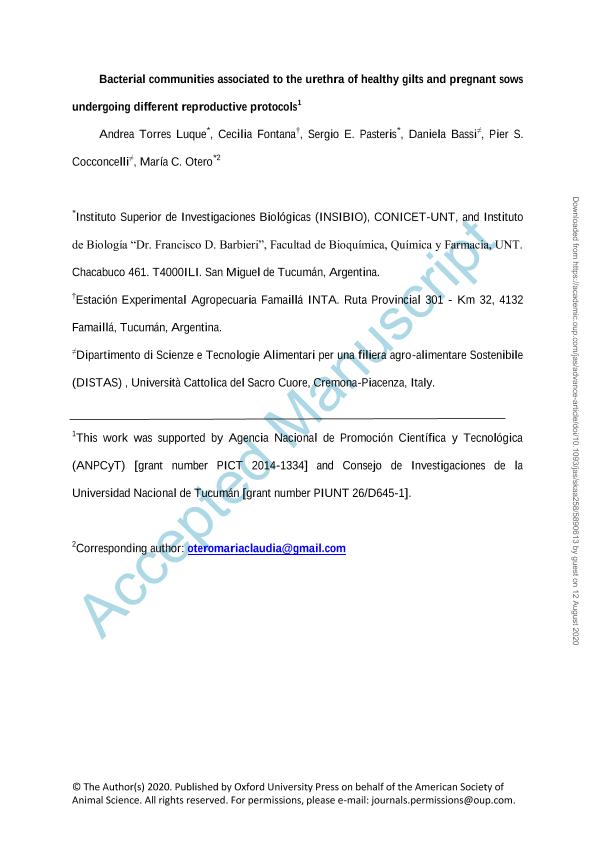Mostrar el registro sencillo del ítem
dc.contributor.author
Torres Luque, Andrea

dc.contributor.author
Fontana, Cecilia Alejandra

dc.contributor.author
Pasteris, Sergio Enrique

dc.contributor.author
Bassi, Daniela
dc.contributor.author
Cocconcelli, Pier S.
dc.contributor.author
Otero, María Claudia

dc.date.available
2021-10-12T20:58:54Z
dc.date.issued
2020-09
dc.identifier.citation
Torres Luque, Andrea; Fontana, Cecilia Alejandra; Pasteris, Sergio Enrique; Bassi, Daniela; Cocconcelli, Pier S.; et al.; Bacterial communities associated to the urethra of healthy gilts and pregnant sows undergoing different reproductive protocols; American Society of Animal Science; Journal of Animal Science; 98; 9; 9-2020; 1-11
dc.identifier.issn
0021-8812
dc.identifier.uri
http://hdl.handle.net/11336/143347
dc.description.abstract
Nowadays, it is known that the urogenital microbiota plays a key role in the urinary health of mammalians. Despite the urinary infections affect the health and the welfare of breeding sows, the urethral microbiota of healthy sows remains unknown. Therefore, this work evaluates the urethral bacterial communities of healthy gilts and sows to determine the presence of Enterobacteriaceae populations, and the structure of this microbiota in gilts (G) and pregnant (P) sows. Samples were collected by scraping the urethral mucosa of G (n = 9) and P sows, which included natural mating (NM, n = 9) and artificial inseminated (AI, n = 7) sows. Samples were analyzed by culture-dependent techniques and 16S-rRNA gene high-throughputsequencing. All females were positive for Enterobacteriaceae culture, without significant differences (Kruskal-Wallis) between G and P groups (median values: 2.78 and 3.09 log CFU/mL, respectively; P = 0.497). Also, the rate of Enterobacteriaceae/total mesophilic microorganisms was individually calculated, without significant differences between G and P sows (median values: 0.61 and 0.66, respectively; P = 0.497). When analyzing the bacterial communities, it was found similar richness in G, NM, and AI; however, diversity was lower in P sows than G (Mann Whitney/Kruskal-Wallis test, P < 0.01). The dominating phyla that constituted a "core microbiome"included Firmicutes, Proteobacteria, Cyanobacteria, Actinobacteria, and Bacteroidetes, which were common for all the studied females. The relative abundance for phyla, families, and genera was estimated, and Firmicutes was significantly higher in NM than AI sows (P = 0.02, Mann-Whitney/Kruskal Wallis test for univariate statistical comparisons); Pseudomonadaceae and Enterobacteriaceae were higher in AI than in NM (Mann-Whitney/Kruskal-Wallis, P < 0.05). Lactobacillus and Pseudomonas were among the dominant genera; however, only Pseudomonas sp. was significantly higher in AI than NM (Mann-Whitney/Kruskal-Wallis, P = 0.006). The results represent the first evidence about the existence of a urethral microbiota that includes Enterobacteriaceae, as well as the patterns of this microbiota in G and P sows. The knowledge of this urethral microbiota might allow for future research to develop innovative protocols to restore and/or preserve the healthy ecology of the urinary microbiome to prevent diseases ensuring the welfare of breeding sows.
dc.format
application/pdf
dc.language.iso
eng
dc.publisher
American Society of Animal Science

dc.rights
info:eu-repo/semantics/openAccess
dc.rights.uri
https://creativecommons.org/licenses/by-nc-sa/2.5/ar/
dc.subject
GILTS
dc.subject
NEXT GENERATION SEQUENCING
dc.subject
PREGNANT SOWS
dc.subject
URETHRAL MICROBIOTA
dc.subject.classification
Otras Ciencias Veterinarias

dc.subject.classification
Ciencias Veterinarias

dc.subject.classification
CIENCIAS AGRÍCOLAS

dc.title
Bacterial communities associated to the urethra of healthy gilts and pregnant sows undergoing different reproductive protocols
dc.type
info:eu-repo/semantics/article
dc.type
info:ar-repo/semantics/artículo
dc.type
info:eu-repo/semantics/publishedVersion
dc.date.updated
2021-07-01T13:52:46Z
dc.identifier.eissn
1525-3163
dc.journal.volume
98
dc.journal.number
9
dc.journal.pagination
1-11
dc.journal.pais
Estados Unidos

dc.journal.ciudad
Champaign
dc.description.fil
Fil: Torres Luque, Andrea. Consejo Nacional de Investigaciones Científicas y Técnicas. Centro Científico Tecnológico Conicet - Tucumán. Instituto Superior de Investigaciones Biológicas. Universidad Nacional de Tucumán. Instituto Superior de Investigaciones Biológicas; Argentina. Universidad Nacional de Tucumán. Facultad de Bioquímica, Química y Farmacia. Instituto de Biología; Argentina
dc.description.fil
Fil: Fontana, Cecilia Alejandra. Consejo Nacional de Investigaciones Científicas y Técnicas. Centro Científico Tecnológico Conicet - Tucumán; Argentina. Instituto Nacional de Tecnología Agropecuaria. Centro Regional Tucuman-Santiago del Estero. Estación Experimental Agropecuaria Famaillá; Argentina
dc.description.fil
Fil: Pasteris, Sergio Enrique. Consejo Nacional de Investigaciones Científicas y Técnicas. Centro Científico Tecnológico Conicet - Tucumán. Instituto Superior de Investigaciones Biológicas. Universidad Nacional de Tucumán. Instituto Superior de Investigaciones Biológicas; Argentina. Universidad Nacional de Tucumán. Facultad de Bioquímica, Química y Farmacia. Instituto de Biología; Argentina
dc.description.fil
Fil: Bassi, Daniela. Universita Cattolica del Sacro Cuore. Dipartimento di Scienze e Tecnologie Alimentari per una Filiera Agro-alimentare Sostenible; Italia
dc.description.fil
Fil: Cocconcelli, Pier S.. Universita Cattolica del Sacro Cuore. Dipartimento di Scienze e Tecnologie Alimentari per una Filiera Agro-alimentare Sostenible; Italia
dc.description.fil
Fil: Otero, María Claudia. Consejo Nacional de Investigaciones Científicas y Técnicas. Centro Científico Tecnológico Conicet - Tucumán. Instituto Superior de Investigaciones Biológicas. Universidad Nacional de Tucumán. Instituto Superior de Investigaciones Biológicas; Argentina. Universidad Nacional de Tucumán. Facultad de Bioquímica, Química y Farmacia. Instituto de Biología; Argentina
dc.journal.title
Journal of Animal Science

dc.relation.alternativeid
info:eu-repo/semantics/altIdentifier/doi/http://dx.doi.org/10.1093/jas/skaa258
dc.relation.alternativeid
info:eu-repo/semantics/altIdentifier/url/https://academic.oup.com/jas/article-abstract/98/9/skaa258/5890613
Archivos asociados
